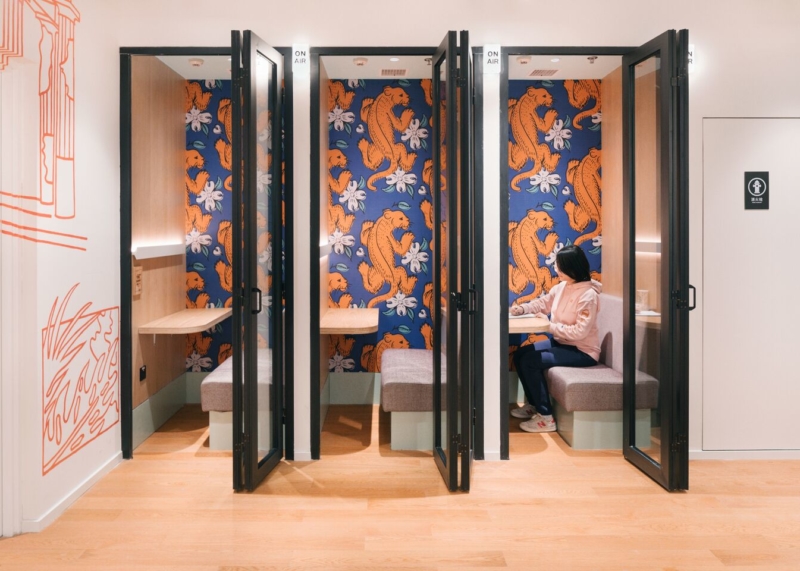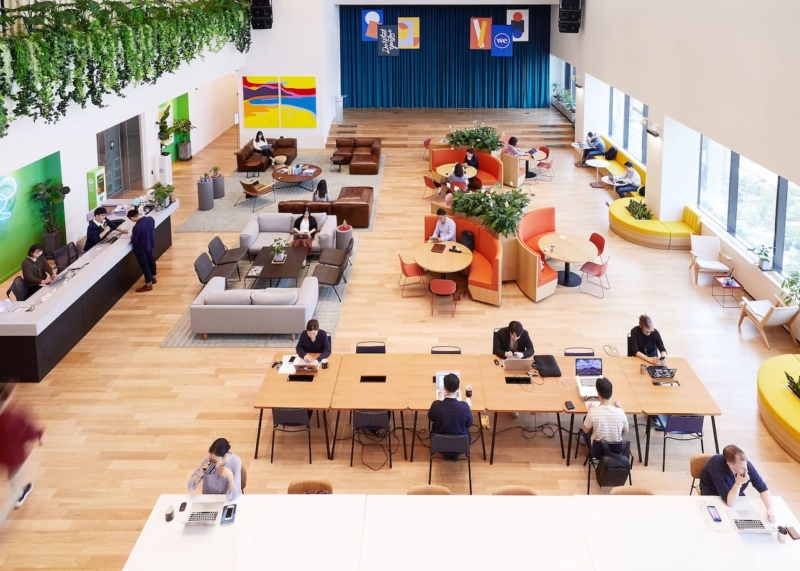Employees today seek both flexibility and autonomy—and companies that wish to attract and retain top talent are thinking outside the standard office setup. Even before the threat of COVID-19 sent employees to work from their homes, companies had been embracing more flexible workspaces and the concept of activity-based working (ABW). Research shows that an overwhelming majority of employees want to return to the office at least one day a week. Here are some kinds of spaces that can serve their various working needs.
- What is activity-based working?
- What are the benefits of an activity-based workspace?
- Eight innovative spatial features for activity-based working
- Phone booths
- A café-style atmosphere with hot desks
- Restaurant-style booths
- Formal conference rooms
- Informal conference rooms
- Soft seating
- Quiet nooks
- Outdoor terraces
What is activity-based working?
Activity-based working is a work style in which employees have different spaces related to the various tasks they need to complete throughout the day, and they are able to choose when and how they work. This might include sitting in common areas to connect with other teams, working in conference rooms to take virtual meetings, and using quiet spaces to focus.
What are the benefits of an activity-based workspace?
A survey of employees by WeWork and Reuters found that when U.S. workers were asked what would make them more satisfied with their job, the top wish was better work areas/facilities (13 percent). That response even edged out higher pay (9 percent), better hours, and more vacation time. Furthermore, the poll showed that workers who reported being satisfied at work used an assortment of ABW office design features—like common areas, dining areas, and phone booths—30 percent more than workers who reported being dissatisfied. Another ABW research study found that organizations that adapted ABW had a 17 percent improvement in overall workplace satisfaction and a 13 percent increase in perceived individual productivity. As such, many forward-thinking companies are recognizing that a flexible workspace, which allows for a diversity of work styles such as ABW, doesn’t just keep employees happy; it has an impact on their bottom line. Providing staff with more freedom to move around, and comfortable surroundings that make it easier to do their jobs, can go a long way.
Eight innovative spatial features for activity-based working
These spatial features in ABW offices are helping enterprise companies break out of the cubicle mold and head into the future of flexible workspace:
Phone booths

When people need a quiet place for a client call or focused work requiring concentration (think writing or data-crunching), they can just slip into a cozy phone booth. This one in WeWork Air China Century in Beijing provides a bright, colorful space with sliding glass doors and comfortable seating, ensuring that employees won’t feel closed in.
A café-style atmosphere with hot desks

The main lounge in WeWork Yeouido Station in Seoul feels more like a bustling café than an office. A model template of ABW office design, its long tables with work desks, semicircle booths for smaller group chats, and intimate couch and coffee-table areas make for a perfect blend of seating options. There’s even a stage set up for informal presentations or perhaps even downtime performances. As for the decor, it couldn’t be more inviting thanks to the mix of bright and traditional leather seating, greenery, and natural light.
Restaurant-style booths

For a quick face-to-face with a colleague (instead of an endless email chain), or just to get a bit of work done in a new location, these diner-like booths present another seating option for employees. At WeWork Taohui Xintian in Beijing, the tinted-glass windows are a nice touch, offering just enough privacy without sacrificing the ability to stay in tune with office happenings.
Formal conference rooms

Meetings are a given throughout the workday, and some require a formal setting, such as sales meetings, monthly brainstorms, or executive strategy sessions. This conference room at WeWork Insurgentes Sur 601 in Mexico City uses a modern minimalist design to create a welcoming take on the standard boardroom. Floor-to-ceiling windows let in stunning views and natural daylight to help support the flow of creative ideas.
Informal conference rooms

Not all meetings require a boardroom, though. Activities like in-person brainstorming or meeting with prospective candidates can benefit from more casual, inviting settings. This conference area at WeWork Purpurina 400 in São Paulo has a laid-back feel with a mix of different seating options.
Soft seating

Employees looking for a place to decompress when in the midst of a challenging project, or those who feel like they do their best thinking in a setting that’s more like a living room, can take refuge in this space at WeWork Antonio Miroquesada 360 in Lima, Peru. The soft seating and vibrant printed upholstery provide an instant pick-me-up.
Quiet nooks

There are times in the workday when everyone feels a need to recharge and refocus in private. At WeWork Seomyeon in Busan, Korea, employees don’t have to go far to access a quiet zone. This comfy corner—an example of another ABW office element, with its plush seating and outdoor view—is perfect for a little downtime or heads-down work.
Outdoor terraces

Fresh air, sunlight, and greenery can all contribute to improved employee health and wellness—supporting improved morale and productivity. The design of this outdoor terrace at WeWork Blue One Square in Gurugram, India, provides the ideal space for working, socializing, or eating lunch.
It’s clear that heads of real estate at enterprise companies have more important jobs than ever before—they have to see to it that employees have access to a physical workspace that meets their individual needs, and that gives them a sense of safety. Implementing ABW workplace designs can have a big effect on employees, from the ability to embrace and celebrate their own unique work style to supporting the creativity and imagination that leads to innovation. Moving toward a more flexible workspace is one way to start.
This article was originally published on August 14, 2019, and has been updated throughout by the editors.
Dawn Papandrea is a freelance writer who covers work, personal finance, and higher education. Her writing has appeared in numerous publications including Family Circle and on Monster.com. Follow her on Twitter.
Rethinking your workspace?









